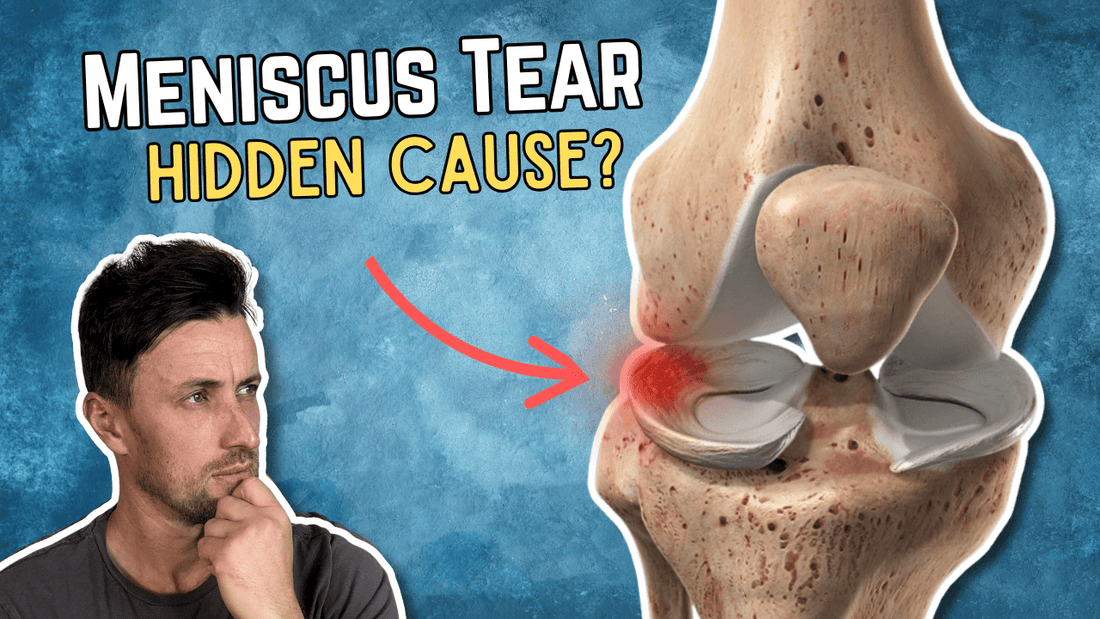
Meniscus Tear Recovery: 4 Exercises to Fix the Root Cause
If you're recovering from a meniscus tear, you might be focused on the pain in your knee. But what if the real cause of your injury isn't in your knee at all? Clinical experience shows that a meniscus tear is often the 'last straw'—the final result of hidden restrictions in your hips and ankles.
This guide will help you understand the root cause of your injury and provide four key exercises to create a safer environment for your knee to heal and prevent future problems.
Why Your Meniscus Tore: It's Probably Not What You Think
When you experience a meniscus tear, it's natural to blame the specific movement that caused the pain. However, from a physiotherapist's perspective, that moment was likely just the trigger.
Your knee is a hinge joint, designed to move forward and back. It doesn't tolerate twisting and rotational forces well. If you have restrictions in your ankle (limiting how your foot points and moves) or your hip (limiting rotation), your body is forced to create movement elsewhere. Often, that compensation happens at the knee, placing unnatural stress on the meniscus over time.
Rehab that only focuses on the knee is incomplete. To truly recover and prevent re-injury, you must look above and below the painful area.
The 4 Essential Exercises to Address the Root Cause
These four mobility exercises are designed to release the common restrictions that contribute to meniscus tears. They target the ankle and hip to help your knee move as it was designed to.
Exercise 1: Banded Ankle Stretch
Goal: To improve dorsiflexion (the ability to bend your ankle and bring your shin forward). A stiff ankle is one of the most common issues seen with meniscal tears.
How it helps: If your ankle is restricted, your body will work around it by either letting your knee cave inwards or turning your foot out during a squat. Both of these changes alter the load on your meniscus. This stretch creates more space and mobility in the ankle joint.
How to do it:
- Loop a resistance band around a sturdy post and place it just below your ankle bones.
- Step forward to create tension, then step your other leg past it into a lunge.
- With your foot pointing straight ahead, gently bend your back knee forward as far as comfortable.
- Aim to move your knee outward (laterally) rather than letting it collapse inward.
- Hold for 30-60 seconds, or gently oscillate in and out of the stretch for 1-2 minutes.
Exercise 2: Calf Stretch Using a Step
Goal: To release tension in the calf muscles (gastrocnemius), which cross both the ankle and the knee joint.
How it helps: Tight calf muscles can pull on the back of the knee and contribute to ankle stiffness. Releasing them helps improve the overall mechanics of your lower leg, taking abnormal pressure off the meniscus.
How to do it:
- Stand on a step with the balls of your feet on the edge.
- Gently lower one heel down as far as you can until you feel a stretch in your calf.
- Try gently rotating your leg inwards and outwards to target different parts of the muscle.
- For a deeper release, use a PNF technique: tense the calf muscle for 5-10 seconds, then relax. You should immediately be able to sink deeper into the stretch. Repeat 2-3 times.
Exercise 3: Seated Hip Rotation Stretch
Goal: To improve external rotation of the hip.
How it helps: A lack of hip external rotation is a major culprit. When you squat or run, if your hip can't rotate outwards, your knee will often collapse inwards (valgus), dramatically increasing rotational stress on the meniscus.
How to do it:
- Sit on a chair and place the outside of your ankle on the opposite knee (similar to a sitting "figure-four" stretch).
- Keep your back straight and hinge forward from the hips until you feel a stretch in your buttock/hip.
- Use the PNF technique: gently press your ankle down against your knee for 5-10 seconds to activate the tight muscles, then relax and hinge forward further.
- Repeat 2-3 times. If this irritates your knee, place a cushion under it for support.
Exercise 4: Couch Stretch
Goal: To release the hip flexors and quadriceps at the front of the hip and thigh.
How it helps: Tight hip flexors, common from prolonged sitting, can pull the pelvis and femur into a position that alters knee mechanics. This stretch creates better alignment and freedom of movement from above the knee.
How to do it:
- Kneel in front of a couch or chair. Place your shin and the top of your foot against the couch, with your knee in the corner.
- Place your other foot flat on the floor in front of you.
- Keeping your back straight, gently push your hips forward until you feel a stretch in the front of your hip and thigh.
- Use the PNF technique: squeeze the front of your hip for 5-10 seconds, then relax and sink deeper into the stretch.
- Repeat 2-3 times. Use a cushion under your knee if there is any discomfort.
Putting It All Together for Lasting Recovery
Performing these exercises isn't about instantly "healing" the torn cartilage. It's about creating a more optimal environment for your knee to function and heal. By removing the "hidden handbrakes" in your ankle and hip, you allow your meniscus to be loaded in a safer way.
After doing these exercises, try a few bodyweight squats. You will likely feel lighter, looser, and find it easier to keep your knees aligned over your feet—a sign that you're already moving more optimally.
Want to Go Deeper with Your Recovery?
For a detailed visual guide and to learn a highly effective strength exercise specifically for meniscus tear rehab, watch the full video on the Your Wellness Nerd YouTube channel.
Subscribe to the channel for more physio-led insights to help you move without pain.
